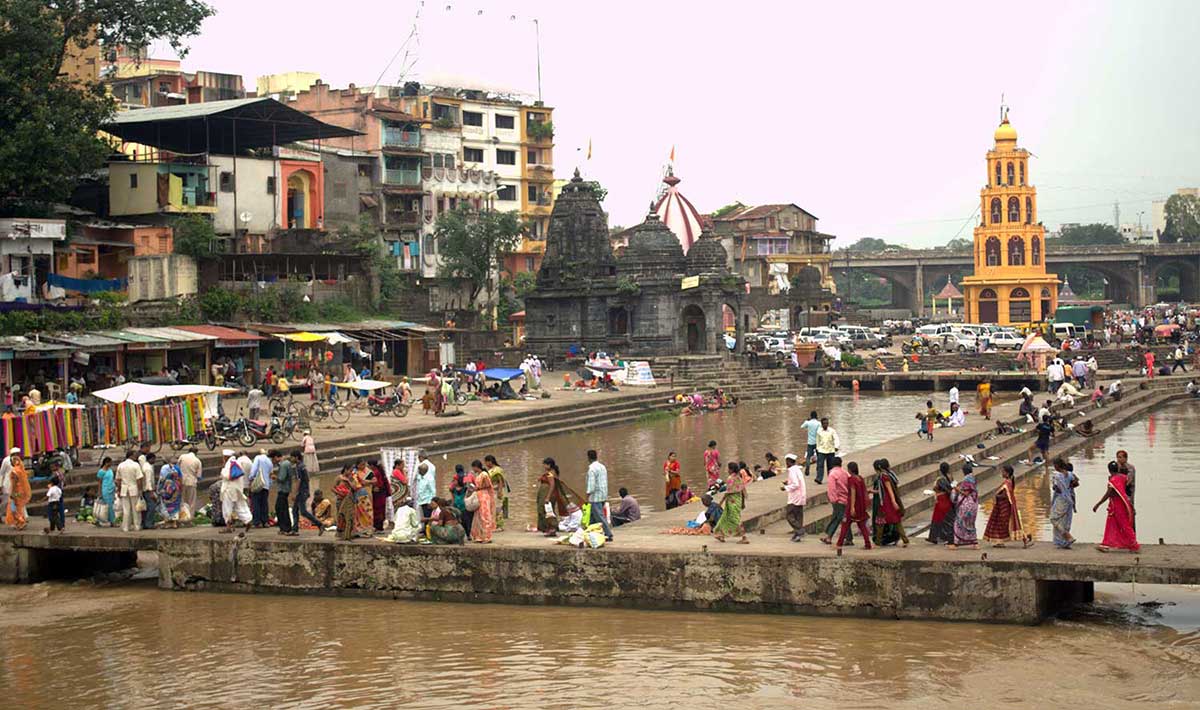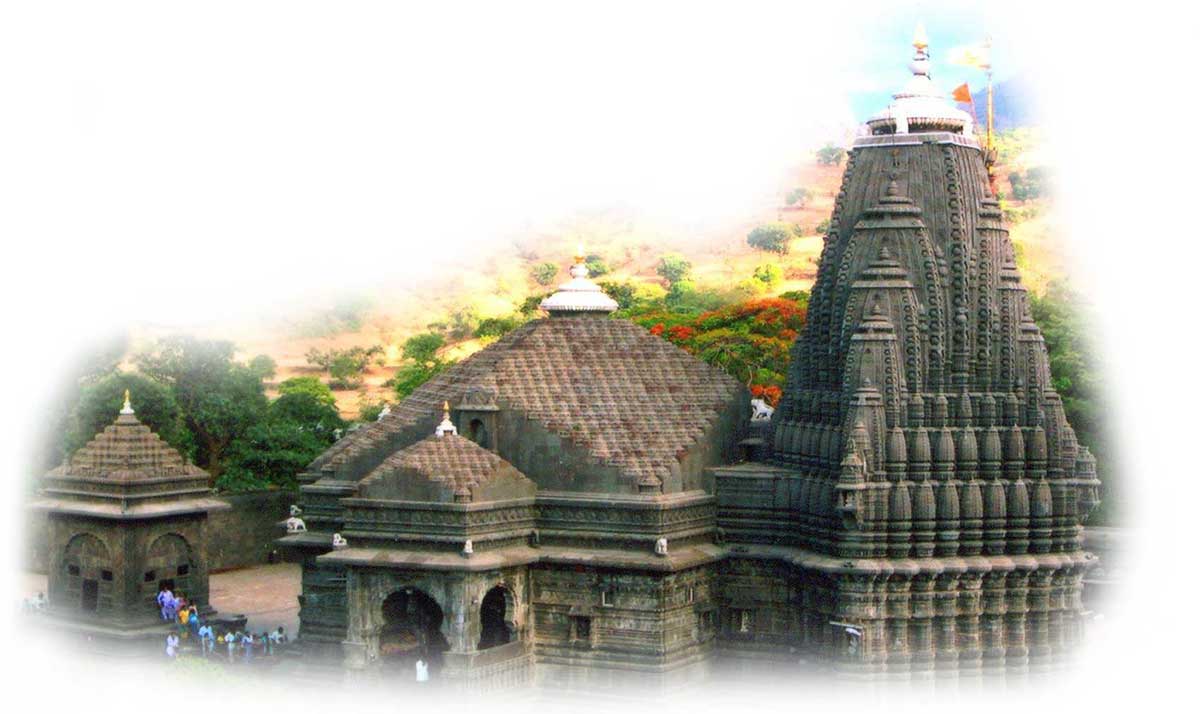
About
Nasik is a city in western India in the state of Maharashtra. Nasik is located in the north-west of Maharashtra near Gujarat state, 171 km (106 mi) from Mumbai and 210 km (130 mi) from Pune and is the administrative headquarters of the Nashik District and Nashik Division. With a population of 1.9 million, Nasik is the third largest city in Maharashtra after Mumbai and Pune. In terms of area it is second largest city after Mumbai and Nashik district is the eleventh most populous district in India.
Nashik is said to be the abode of Lord Rama during his 14 years in exile here. It is located on the banks of the Godavari which originates in the south-west of the city at Triyambakeshwar. It is one of the four places in the world where the Kumbh Mela is held making it one of the holiest Hindu cities. The city is a site for more than 100 ancient temples including the Kalaram Temple and Triyambakeshwar Shiva Temple.
The Anjaneri (or Anjneri) mountain, located 7 km from Triyambakeshwar in the Nasik district, is also claimed as the birthplace of Hanuman.
Nashik ranks 16th in a global study of fastest developing city conducted by The City Mayors Foundation, an international think tank on urban affairs and has witnessed significant economic progress in the last decade. The Delhi Mumbai Industrial Corridor (DMIC) project has earmarked the Sinnar and Igatpuri regions of Nashik district as a region for development of dedicated freight corridors. The city is also known as the Wine Capital of India since it accounts to a large amount of the country's grape export and there are many vineyards in and around Nashik. It also plays an utmost important role in agriculture. Onion, tomatoes and many other vegetables are exported from Nashik to various parts of the world. In addition, Nashik is known for its picturesque surroundings, climate and tourism.

Triyambakeshwar Temple in Nasik
Shri Triyambakeshwar Temple is located at a distance of about 30-km from Nasik in Maharashtra near the mountain named Brahmagiri from which the river Godavari flows. Triyambakeshwar Temple is revered as one of the 12 Jyotirlinga shrines of Shiva and as the source of the river Godavari. Just as Ganga is known as Bhagirathi and is one of the most important river in North India, in the same way, Godavari is also known as Gautami Ganga and is the most sacred river in South India.

According to Shiv Purana, it is because of the earnest request of Godavari, Gautam Rishi and other gods that Lord Shiva agreed to reside here and assumed the famous name Triyambakeshwar. Interestingly, locals refer to the river here as Ganga and not as Godavari. All the heavenly Gods promised to come down to Nasik, once in twelve years, when Jupiter resides in the zodiac sign of Leo. On this a grand fair is organized at this place. Devotees take a holy bath in the Gautami Ganga and then seek the blessings of Triyambakeshwar.
Legend Behind Triyambakeshwar Temple
Legend goes that a sage name Gautam Muni resided on the Brahmagiri hill with his wife Ahilya. By virtue of his devotion, the sage received from Varuna, a bottomless pit from which he received an inexhaustible supply of grains and food. The other rishis, jealous of his fortune, arranged for a cow to enter his granary and caused it to die as Gowtam Rishi attempted to ward it off with a bunch of Darbha grass.
Gautam Rishi, therefore, worshipped Lord Shiva to bring the Ganga down to his hermitage to purify the premises. Pleased with devotion, Shiva requested Ganga to flow down and make Sage Gautam pure. After that Ganga flowed down. Lord Shiva told Ganga to stay there eternally for the good of everyone. All the Gods started singing the praises of Gautam Rishi, Ganga and Lord Shiva. On the request of all the Gods, Lord Shiva resided by the river Gautami by the name Triyambakeshwar (one of the Jyotirlingas). Hindus believe that Trimbak Jyotirlinga is one, which fulfills everyone’s desires. It emancipates all from their sins and miseries.
Another popular legend behind Triyambakeshwar Temple is the legend of Lingodbhava manifestation of Shiva. It says once Brahma and Vishnu searched in vain to discover the origin of Shiva who manifested himself as a cosmic column of fire. Brahma lied that he had seen the top of the column of fire and was hence cursed that he would not be worshipped on earth. In turn Brahma cursed Shiva that he would be pushed underground. Accordingly, Shiva came down under the Brahmagiri hill in the form of Tryambakeshwar. Triyambakeshwar Temple is the only place where Shivlinga is not out but it’s inside the floor.
Some scholars say that Goddess Parvati also came down along Lord Shiva and Ganga. The place is therefore called Tryambakeshwa (three lords). Others believe that the place is so called because of the presence of three Shivlinga of Brahma, Vishnu and Mahesh. The Shivlinga of Lord Mahesh has always-flowing water among the three Shivlingas.
Places of Interest
Panchavati
Panchavati has significant religious significance for Hindus with a temple complex on the bend of the Godavari river, which includes Kalaram Temple. It is a pilgrimage site, with the Kumbh Mela, the largest peaceful gathering in the world – involving over 100 million people in 2013, taking place here once every twelve years in rotation with Haridwar, Allahabad, and Ujjain.
In Hindu theology, as outlined in the epic Ramayana, Panchavati was the place in the forest of Dandakaranya (Danda Kingdom), where Rama built his home along with his wife Sita and brother Lakshman during their period of exile in the wilderness. Panchavati literally means "a garden of five banyan trees". These trees are said to have been there during the exile of Lord Rama.There is a place called Tapovan where Lakshmana, the brother of Rama, cut off the nose of Surpanakha, the sister of Ravana, when she attempted to kill Sita. The entire Aranya Kanda of Ramayana is set in Panchavati.
Pandavleni Caves
It is the oldest of its kind in the Maharashtra. Visitors can come across various Buddhist Viharas. Also the caves house extensive writings in Brahmi scripts. Behind the caves, Asia’s famous artillery center is located. The Indian Army possesses the center and the entry of civilians is restricted.
Ramkund
This tank is a holy place for Hindus. Devotees believe that a dip in this tank will fulfill their wishes. According to Hindu mythology, Lord Rama bathed in this tank during his stay in Nashik.
Muktidham Temple
Located seven km away from Nashik, this temple with intricate architecture was constructed out of white marble. Tourists can see carvings of 18 chapters from Bhagawad Gita, the great Indian religious text.
Kalaram Temple
This temple is dedicated to Lord Rama. It was built in 1794. Tourists are enthralled by its huge 70 feet black stone structure. The temple’s gold-plated copper pagodas are enriched with intricate art work.
Sundarnarayan Temple
Situated on the corner of Ahillyabai Holkar bridge, this temple was built in 1756 by Chandrachud. The sanctum sanctorum houses the idol of Lord Vishnu.
Sita Gumpha
This Gumpha is located near Panchavati in Nashik and it is one of the crowd pullers of the city. Tourists can reach the cave after taking steep, narrow flights of steps. Within the cave,visitors can worship the idols of Lord Rama and his consort Sita Devi, along with his brother Lord Lakshmana. Hindu mythology says, it was from this place Sita Devi was kidnapped by the demon King called Ravana.
Coin Museum
Tourists who are really interested in gaining information about various currency systems of ancient India must visit this museum in Nashik. The museum houses a huge collection of real coins, replicas, line drawings, articles and photographs of coins.
Someshwar Temple
This, one of the oldest temples dedicated to Lord Shiva, is located six km away from Nashik on the road to Gangapur. The temple is located on the banks of the Godavari river.

Transportation
By Air
Nasik has a domestic airport and thus, tourists coming from international destinations have to travel to Mumbai International Airport first and thereafter, take domestic flights to Nasik, which are offered by a number of airlines.
Nasik is just 90 Kms away from famous pilgrim centre "Shri Sai Baba Sansthan-Shirdi" and 160 Kms away from the Maharastra Capital city "Mumbai".
By Train
Nashik Road Railway Station is the major railway station in the city which is around 10 km (6.2 mi) from the central area of the city. Deolali railway station is around 20 km from the city which serves the military cantonment area.
Nashik Road railway station is an important railway station for Central Railway it generates highest revenue in Bhusawal division.Manmad railway station comes under Nashik district and serves huge importance for visitors travelling towards Shirdi from North and South India.Igatpuri railway station is another major railway station where DC to AC conversion of electric lines are carried out by changing the engine.It has four major platforms. the fourth platform is announced recently.
Nashik Road falls on the Mumbai–Bhusawal route of the Central Railways. Nashik is directly connected to various major cities in India like Mumbai, New Delhi, Kolkata, Nagpur, Kanpur, Guwahati etc. There are a few trains connecting Southern and Northern parts of India which travel via Nashik.
Nashik will also be getting a rail connectivity to Pune through Nashik Pune Rail line and to Indore by Manmad Indore Rail Line and a new platform as announced in Rail Budget debate recently
To book your tickets Click Here
By Bus
Nashik is on the intersection of two National Highways: the Mumbai–Agra Highway NH-3 and the Nashik–Pune Highway NH-50. Apart from these, other major cities like Aurangabad are connected via a state highway which is also 4 lane highway. Nashik is easily accessible by road from Gujarat state in western India. There are other numerous State Highways which offer very good road connectivity to Nashik. Nashik is well connected to Mumbai through Mumbai Nashik Expressway which is a part of Mumbai-Agra Highway (NH3)connects Dhule and Indore to the city on the other side of the highway. Pune is connected through NH 50 which is to be upgraded into a four lane road soon.
To Book your journey Click Here